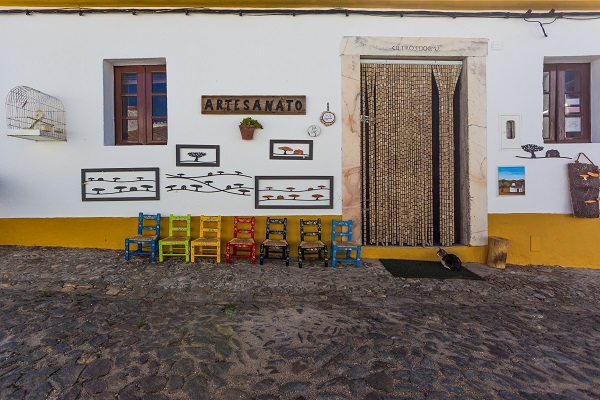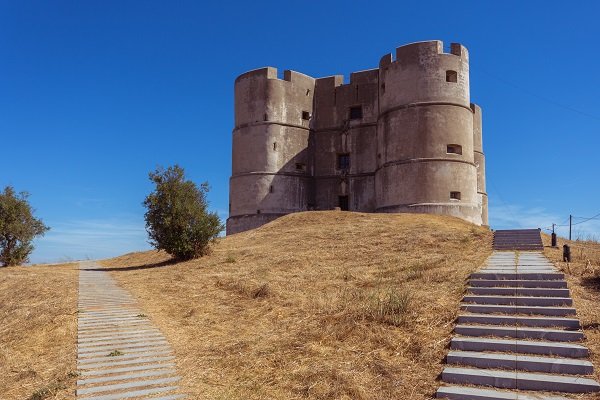It had been a while. Twenty years, maybe more? I have a vague recollection of Évora Monte (or Évoramonte, both are correct). It is the village you cannot miss — set on a very high hill, seen from miles away, and unmistakable. Its odd castle, looking much like a wedding cake — soaring high above the cork forests of the Alentejo. It is a rare walled town, with a rare palace/castle.
As a kid, I had a bucket list of castles, and the Alentejo, with its rolling landscapes, and proximity to Spain has more than its fair share. So, a few decades later, it was time to return to this tiny village surrounding a massive castle to see how things had changed.
Timeless is a word that gets tossed around a good deal. And, I have no doubt that Portugal’s Alentejo gets that title all too often. But it is not the case. Romans, Arabs and even Visigoths left their traces here. New farming techniques, climate change, dams and new wind turbines all have changed the landscapes. We think that if something never changes, it is reassuring — but the Alentejo has changed, but it has not stopped being true to itself.
Here, up high over the cork forests, at Évora Monte - things had changed — and in a very good way. First, the castle itself is not what it appears to be. And the rounded Renaissance palace is actually a total reconstruction, rebuilt some 70 years ago, as part of a national program that re-build churches, monuments and castles across Portugal. Inspired by the ruined original, it is a reminder of what life was like on this mountain top five centuries ago. But what is real is the tiny village made up of a single cobblestone road that is set inside its walls.
My first visit found the castle mostly empty, and the tiny village mostly uninhabited. Today, 11 families live in the walls, and a budding cultural offering exists in the tiny houses. Climbing up the narrow road to the castle gate, there were surprises on the other side. And that set of surprises shows how much the Alentejo has evolved. The great find here is The Place at Évoramonte, a very well appointed inn, set in a few of the original homes. Classic on the outside, but modern and re-imagined on the inside, Vicky and Mitch had brought something of their intentional lives in this very comfortable retreat. Art from their travels to Asia adorns the ancient walls, while the furniture is modern and comfy, and rooms are climate controlled. But, what wins the real prize are the endless views, with all of the Alentejo cork forests on display for miles and miles. Birds soar, the sun shines high above the classic cloudless plains, and the light is a thing of art. Sunset is a masterpiece, and the only sound you hear are the bells of sheep grazing well below the castle walls.


Artesanato Celeiro Comum is a craft workshop a few feet away, it is the workshop of Inocencia Lopes. Here you can find not only hand painted stone houses, but a wide array of gifts. There are more than 60 of her painted rock houses on the cobblestone streets of the town. And, this is just one of the handful of registered workshops that produce the UNESCO Heritage Figures of Estremoz. Their evolution is a trip back to the days when elaborate nativity scenes were made to share the story of Christ. Like a diorama, they can include local characters, shepherds. Farmers, and rural people. These figures emerged to be their own thing, and took on their own story. They were shopkeepers, townspeople, street-sellers, and then elaborate symbols, such as love is blind. It takes a full week to make a figure, from the craft of the clay, to the firing, to painting, and drying. They are priced quite affordable, and are unique to this region. These clay wonders are the product of a weeklong production process: first the bits of the clay figures are assembled and then fired in a kiln. They are then painted by hand and covered with a clear varnish. These fig-ures are in the local costumes of Alentejo that date back to the seventeenth century. It is a craft that is attached to the central Alentejo region, since the vast majority of the figures depict natural elements, local trades and events, popular traditions and legends.
Across the road, the former town hall has changed just a bit since the 18th century. Ervas de Evoramonte sells aromatic plants, olive oil, honey and beeswax organic oil, raw honey and wax — all from local aromatic plants planted and harvested in the region. And there is a working loom, creating the traditional mantas of the region one swoop at a time. They also sell traditional examples of rugs from nearby towns.
* Jayme H. Simões is a travel blogger on Portugal. He grew up in Chicago but spent summers exploring Portugal with his family.



